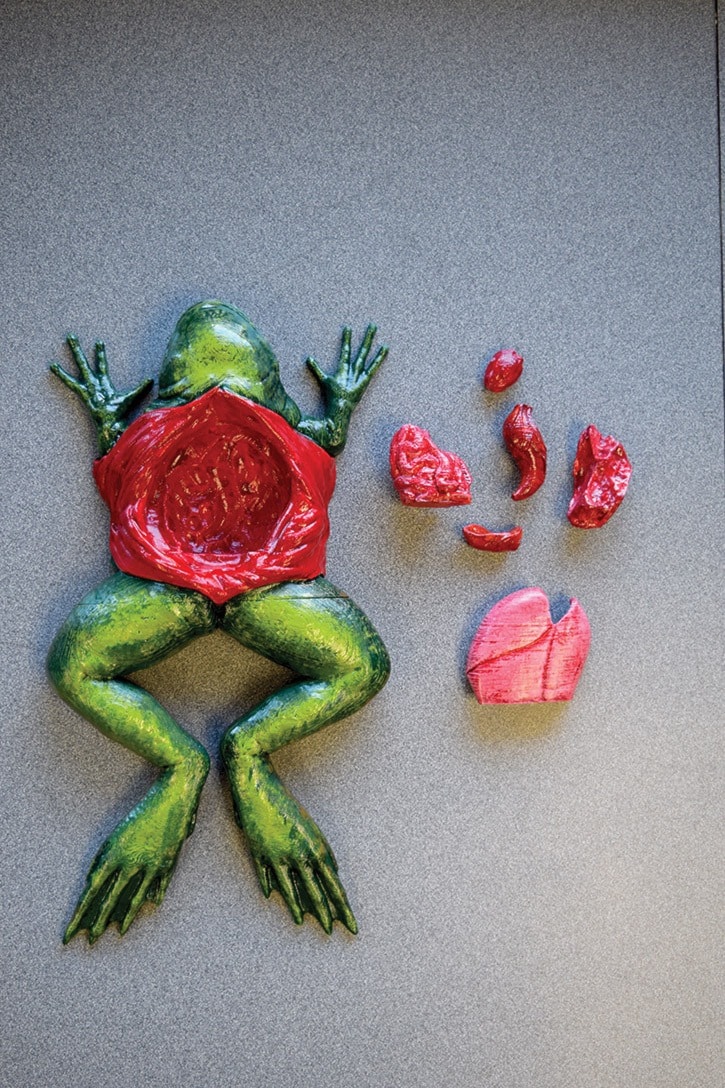Craig Munroe
Special to the Tribune/Weekend Advisor
Until recently my experience with 3D printers was limited to abstract news stories about odd things people, namely engineers, were making. I always had the misconception 3D printers carved smaller objects out of large slabs of some ‘unknown’ Buck Rogers-type substance. My understanding and personal experience with 3D printing was dramatically altered when one of the Industrial Education teachers at Lake City Secondary, Nick Macdonald, came to me one day early last year holding a 3D printed gear.
In the ensuing conversation Nick informed me the cog he had printed was a replacement cog for the 3D printer he had assembled from a purchased kit. I asked him, “Why the cog?” and he went on to explain if the part wears out he now has a replacement part and was now in the process of printing several other key parts that were prone to wearing out. I asked where this was taking place and Nick informed me he had set up the 3D printer in the back of the shop teachers’ prep room.
A quick morning ‘field trip’ to the shop teacher prep room revealed my first glimpse of a 3D printer quietly humming away making replacement parts for itself. Truthfully, visions of the Terminator briefly crossed my mind but any anxiety was quickly put aside as I leaned in for a closer look and saw we were still only dealing with plastic.
3D printing for Nick was a passion borne simply out of his insatiable curiosity in terms of wanting to know how things work.
That being said Nick is a dreamer and wants to somehow formulate this new technology into course work that would expose many students to this up and coming process. Nick walked me through the layout of the 3D printer from top to bottom explaining how what major component did and how he himself had learned by error, and was still learning, what worked and what didn’t work regardless of what the owner’s manual said.
Nick had an incredible amount of support in developing his knowledge of the 3D printer from one of the school district Information Technology team members Aaron Ulrich. Aaron and Nick, being good friends, built and developed a 3D printer each for their own personal use and had leaned on each other’s skill sets in setting up both printers. Aaron is an incredibly capable computer scientist who independently researched, sourced, and implemented a prototype 3D printer that would be a viable option for wide spread use within our school district. Nick is one of those teachers who can assemble and build just about anything given a set of tools and an idea, so the two made a natural pairing for the roll-out of an in-school pilot project.
Nick and Aaron both had their printers hooked up at the school and had them continually running so that they could further define their knowledge base and skills in working with 3D software and printer interfaces. Needless to say Nick and Aaron were producing all sorts of novel items like (1:10 scale WWII tanks, miscellaneous gears and cogs, chess pieces, 12” tall model figures, and replacement parts for the printer itself) as they pushed the 3D printers’ capabilities, while still working out technical production issues along the way.
In the following weeks Nick, whose enthusiasm was contagious, presented me with the idea of reintroducing a drafting program at LCSS with 3D printing being an addition to the coursework to address the new curriculum. Although an informal discussion I had asked Nick to prepare and submit a course outline that involved 3D printing to some degree.
The proposal Nick submitted initially was based on a full implementation of a semester length, Grade 10-12 program that addressed all avenues of a drafting curriculum. I was completely in support of this program but was still wanting more as I was keen to see and build the program from the proverbial grassroots — starting in Grade 8!
Currently, as in many Grade 7-9 school structures, Grade 8 students are exposed to electives in a format known as an Expo rotation. Students are exposed to eight different elective options in four week segments so that when they enter Grade 9 they can choose their elective options with some background knowledge of what they are signing up for as a course. Nick took my suggestion and incorporated 3D printing into the Tech Ed (metalwork) Expo rotation course outline seamlessly. Today in our Grade 8 expo Tech Ed. rotation students begin learning the basics of drafting, then move into the computer lab, and begin work on design and development of a plan for their metalwork project, first in 2D, then in 3D. Students are required to 3D print their project, a bottle opener, and once complete then move to the metal work shop to fabricate the working edition. The 3D prototype has led students to see how, and if, their designs will function ‘properly’ prior to working with metal.
Student feedback has been very positive with the project.
What gave me the most satisfaction is how I started with an idea and made it come to life, it was pretty cool,” said Grade 8 student Tiara Solomon.
Program plans are still developing to include the full implementation of a Grade 9 elective offering for the fall of 2017.
Moving forward, Nick has plans to 3D print models of dissection frogs that would be painted by art classes and used by biology classes to support the study of the anatomy of frogs without having to dissect, an option for squeamish biologists. My personal investment into the program was to paint the prototype.
I think it turned out OK. Overall the whole experience has been an incredible learning adventure for all the students, teacher Mr. Macdonald, IT Support Tech, Mr. Ulrich and myself, a true community of learners.
Craig Munroe is currently a Vice-Principal at Lake City Secondary in Williams Lake.
